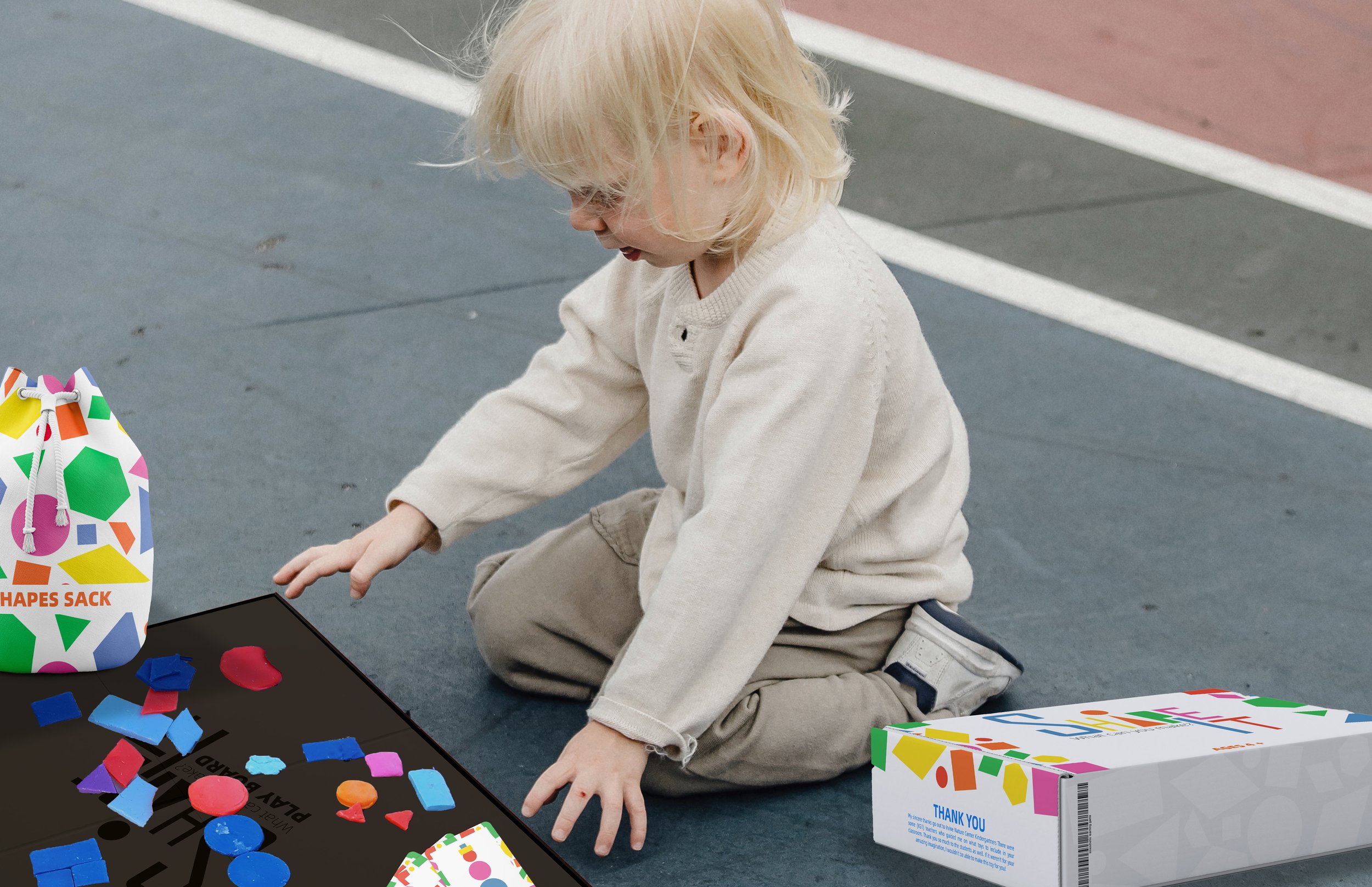
Overview
Type: College Concept Project
Industry: Education / Product Design / Toy Development
Scope: Product Design, Visual Identity, Packaging, Brand Concept
Shape It is an educational toy concept designed to support kinesthetic learning in early childhood. Developed in collaboration with students and educators at the Irvine Nature Center, the project aimed to merge tactile play with cognitive development, language association, and eco-conscious design.
The Objective
The goal was to design a toy that was both engaging and developmentally supportive—without relying on loud colors, plastic materials, or overstimulating features. The challenge was to create something tactile, safe, and intuitively educational while still standing out on shelves.
The Product Overview
Shape It features soft playdough shapes coated with toxin-free glue for easy cleaning and durability. The kit includes:
Abstract stacking pieces
24 illustrated play cards with images and text for word association
A durable black matboard suitable for outdoor learning environments
This setup allows for a flexible and engaging learning experience while promoting exploration, vocabulary, and sensory play.
My Approach - Research & Development
I began with in-depth research into early childhood development stages, Montessori learning principles, and nature-based education to guide the toy’s structure and purpose. A key resource was Kathleen J. Batt's "The Implementation of Kinesthetic Learning Activities to Identify. Geometric Shapes with Preschool Students, July 2009.” which supported the decision to focus on hands-on, movement-based play for shape recognition. These insights shaped a product that is both educational and intuitive, promoting cognitive development through tactile exploration.
Toy Structure & Play Experience
Embark on a journey of exploration and creativity as we develop unique toy concepts that align with the educational objectives of the Irvine Nature Center. Our attention to safety standards ensures that each toy meets or exceeds industry regulations, providing parents with peace of mind while their children learn and play.
During my first week at the Irvine Nature Center, I noticed a common theme among parents: a desire for their children to become more familiar with letters and word recognition. In response, I conducted a simple experiment—offering children two options: cardboard letters for spelling and colorful shape blocks for open-ended play.
While a few explored the letters briefly, most children were naturally drawn to the textures and vibrant colors of the shape blocks. They quickly shifted focus to imaginative building, creating their own forms and narratives. This observation reinforced a key insight: young learners engage more deeply when activities are sensory-rich, tactile, and visually stimulating—a lesson that directly informed the design of Shape It.
Cardboard Letters & Colored Blocks Observation
After further research, I chose to focus my educational activity on geometric shapes and kinesthetic learning—both aligned with Irvine Nature Center’s emphasis on imagination and hands-on exploration. My initial prototype used foam-like materials to incorporate shape, color, texture, and text, aiming to create a multi-sensory learning experience. However, due to safety concerns for preschool-aged children, I pivoted to a safer alternative: Playdough. To maintain structure and hygiene, I coated the Playdough shapes in non-toxic glue, resulting in a safe, durable, and stimulating toy suitable for early learners.
Material Exploration & Prototyping
On the final day at the Irvine Nature Center, I introduced Shape It to the students—and was immediately met with smiles and excited energy. I laid the shapes and play mat out on the grass, encouraging free exploration. The children quickly began creating collages and imaginative patterns, fully immersed in play. One student, Aiden, instantly recognized the Playdough material and enthusiastically engaged with the shapes, asking thoughtful questions that showed both curiosity and comprehension. The experience validated the toy’s potential to inspire learning through tactile discovery and joyful interaction.
Field Testing & Real-World Play
Results & Outcome
Designed a product aligned with early childhood learning frameworks, accompanied by a cohesive brand and packaging system appealing to both children and parents. The concept was presented at an academic exhibition, receiving strong positive feedback from educators and peers.
Shape It demonstrates how strategic product design and brand storytelling can effectively support early learning, reflecting my dedication to creating thoughtful, engaging, and developmentally intentional experiences—from initial concept through to visual identity.
Teacher’s Observation and Feedback
After seeing the initial excitement among the children, I observed the next phase of the game led by the facilitator. She introduced play cards with challenges, prompting the kids to create subjects like boats, houses, or animals, which encouraged strong image and word associations. Some children quickly grasped the challenges and became even more engaged with the activity. The facilitator thoughtfully explained the materials used, highlighting their safety and the ease of cleaning the shapes—important factors for maintaining a hygienic and adaptable learning environment. We were impressed by her careful selection of familiar materials and her practical clean-up solutions. She also shared upcoming plans to incorporate Playdough for creating new shapes, which we felt would further enrich the children’s creative experiences.

